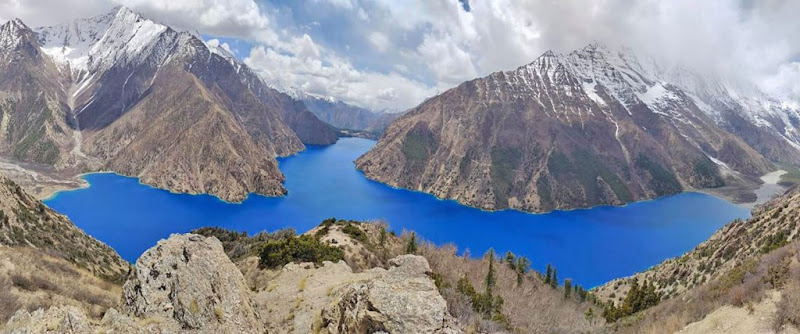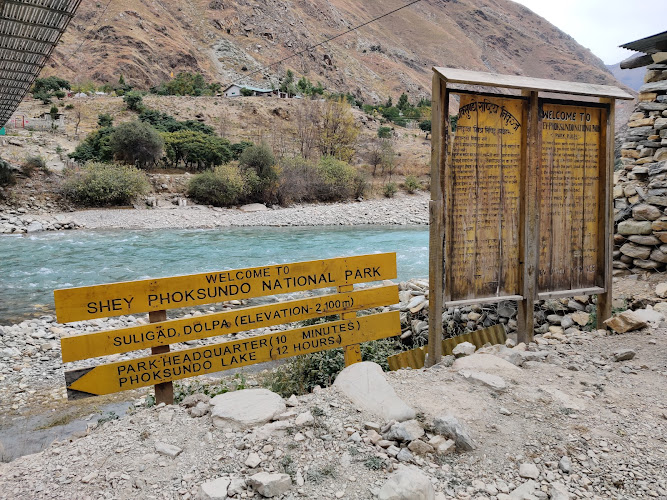


Shey phoksundo national PARK - Turquoise Alpine Lake & Tibetan Buddhist Culture
Suligad, Dolpa Suligad, 21400
Deep in the rain shadow of the Dhaulagiri massif, where Nepal's geography transitions from Himalayan peaks to the windswept plateaus of the Tibetan world, a turquoise lake shimmers at 3,611 meters like a sapphire dropped from the sky. Phoksundo Lake, plunging 145 meters deep and stretching nearly five kilometers in length, glows with an otherworldly blue that seems impossible, as if the water absorbed every wavelength of light except the pure cerulean of high-altitude skies. This is the heart of Shey Phoksundo National Park, Nepal's largest protected area at 3,555 square kilometers and the country's only Trans-Himalayan park, a designation that captures its position straddling the ecological boundary between the Himalayas and the Tibetan Plateau.
Established in 1984 and expanded to its current size, Shey Phoksundo protects ecosystems that exist nowhere else in Nepal. The park spans altitudes from 2,130 meters in the Suligad Gorge to 6,885 meters at Kanjiroba Himal, but it's the character of the landscape—not merely its elevation—that defines its Trans-Himalayan nature. The southern slopes still receive monsoon moisture and support forests of blue pine, spruce, and cypress. But cross north through the park and the rain shadow effect intensifies until vegetation thins to hardy grasses, thorny shrubs, and the stubborn junipers that somehow extract life from soil that seems more dust than earth. This is high-altitude desert, a landscape of ochre cliffs, wind-sculpted rock formations, and vast skies that feel closer to Tibet than to the green hills of Kathmandu.
Peter Matthiessen immortalized this remote corner of Nepal in his 1978 masterpiece "The Snow Leopard," a narrative that braids together his two-month trek with naturalist George Schaller, his Buddhist explorations, and his quest to see the elusive snow leopard around the ancient monastery of Shey Gompa. The book transformed Dolpo from an unknown region into a place of pilgrimage for seekers drawn by Matthiessen's lyrical descriptions of landscape and spiritual searching. The Shey Gompa mentioned throughout the text—referred to as "Crystal Monastery" for its rock-crystal shrine—sits at 4,390 meters near the park's northern boundary, a cluster of stone buildings clinging to barren slopes where Tibetan Buddhist lamas maintain traditions that predate the Buddhism practiced elsewhere in Nepal.
This is Bon-po territory, practicing the ancient shamanistic religion that dominated Tibet before Buddhism's arrival. The remote villages scattered through Upper Dolpo preserve Bon traditions alongside later Buddhist influences, creating a cultural landscape where prayer flags flutter above monasteries adorned with swastikas—the Bon symbol for eternity—and where religious festivals follow calendars unchanged for millennia. The villages of Ringmo, perched above Phoksundo Lake's southern shore, and Shey, guarding the northern approaches, represent some of Nepal's most isolated permanently inhabited settlements, accessible only by foot or helicopter.
Wildlife adapted to these harsh conditions includes species at the edge of their biological limits. Snow leopards prowl the upper reaches, their populations among the healthiest in Nepal thanks to the park's remoteness and healthy blue sheep populations. These bharal, or Himalayan blue sheep, serve as the snow leopard's primary prey, their herds grazing on impossibly steep slopes where their bluish-grey coats provide camouflage against weathered rock. Himalayan tahr, musk deer, Tibetan argali with their massive curved horns, and the Himalayan wolf complete the assemblage of large mammals. Red pandas inhabit the park's southern forests where moisture levels support rhododendron and bamboo. Bird species include the Tibetan snowcock, Himalayan griffon vultures riding thermals above high valleys, and blood pheasants that explode from underbrush in crimson flashes.
But the park's most extraordinary feature remains that impossible blue lake. Phoksundo's color defies simple explanation—it results from sunlight scattering off glacial rock flour suspended in the water combined with the lake's extraordinary depth and the crystalline clarity of high-altitude air. No outlet drains the lake; instead, water seeps through the moraine dam at its southern edge, emerging as springs that feed the Phoksundo Khola downstream. The Ringmo village locals consider the lake sacred, forbidding fishing or swimming, though whether this prohibition stems from religious reverence or practical concern about hypothermia in water that never exceeds a few degrees Celsius remains unclear.
Reaching Phoksundo represents an expedition rather than a casual trek. Most visitors fly from Nepalgunj to Juphal Airport at 2,475 meters—a 35-minute mountain flight that lands on a short, tilted runway carved into a hillside. From Juphal, the trail to Phoksundo Lake covers roughly 50 kilometers and typically requires 3-4 days of hiking through river gorges, over forested ridges, and past terraced barley fields before emerging at the lake's southern shore. The alternative involves weeks of walking from the roadhead at Dunai, though few trekkers choose this marathon approach.
The Phoksundo Lake Trek typically spans 9-12 days round-trip from Juphal, allowing time for acclimatization and exploration around the lake. But for those with permits, stamina, and 3-4 weeks, the Upper Dolpo Circuit ventures deep into the restricted zones beyond Phoksundo, crossing high passes to reach Shey Gompa and continuing through a landscape that feels untethered from modern life. These restricted area permits cost $500 for the first ten days plus $50 per additional day, deliberately limiting visitor numbers to protect both ecosystems and traditional cultures from tourism's disrupting effects.
The trekking season compresses into narrow windows. Spring, from April through May, offers warming temperatures and the first wildflowers but can bring unsettled weather and snow-covered passes. Autumn, from September through early November, delivers the most reliable conditions: clear skies, stable weather, and comfortable daytime temperatures offset by nights that plunge below freezing. Winter transforms the region into an inaccessible ice fortress with temperatures dropping to -30°C and snowfall closing passes. The monsoon affects Dolpo far less than areas south of the Himalayan crest, but June through August still brings occasional rain and cloudy conditions that obscure mountain views.
Logistics demand careful planning. Trekkers must be fully self-sufficient with camping gear and food supplies for the entire circuit, as no teahouse infrastructure exists beyond the Phoksundo Lake area. Hiring local guides and porters from Dolpo communities both enhances safety and ensures tourism income benefits the region's residents. The Dolpo people, descended from Tibetan traders who crossed high passes for centuries, maintain a reputation for honesty and resilience forged by generations of survival in one of Earth's harshest inhabited environments.
Shey Phoksundo National Park preserves more than ecosystems; it protects an entire way of life at risk of vanishing. The villages of Upper Dolpo empty slowly as young people migrate to lowland cities seeking education and employment, leaving behind aging populations that struggle to maintain irrigation systems, agricultural terraces, and monastery traditions. Tourism provides one of the few economic incentives for people to remain, though the restricted permits and difficult access limit numbers to sustainable levels.
For those who make the journey, Phoksundo offers something beyond spectacular scenery or wildlife encounters. The region's isolation strips away modern life's distractions, leaving only rock, sky, wind, and the thin thread of trail connecting one stone settlement to the next. Whether you glimpse a snow leopard matters less than experiencing the landscape that shapes them, understanding the altitude that filters out all but the most determined life, and witnessing human communities that persist against odds that would crush softer cultures. This is Nepal at its most extreme and most authentic, where the journey itself becomes the destination and where that impossible blue lake waits like a reward for pilgrims who cross half the country to stand on its rocky shore.
Park Features & Amenities
🏃 Activities
- ✓ Hiking
🏗️ Amenities
- ✓ Barbecue grill
- ✓ Picnic tables
- ✓ Public toilet
Crowd
- ✓ L G B T Q+ friendly
- ✓ Transgender safe space
🎠 Children
- ✓ Good for kids
- ✓ Kid-friendly hikes
🐕 Pets
- ✓ Dog park
- ✓ Dogs allowed
Other
- ✓ L G B T Q+ friendly
Visitor Information
🕐 Best Times to Visit
Spring (Mar-May): Pleasant weather, blooming flowers
Autumn (Sep-Nov): Clear skies, comfortable temperatures
Early Morning: Best for wildlife viewing and photography
🗺️ Getting There
By Car: Suligad, Dolpa Suligad, 21400
Public Transport: Local buses and taxis available
Walking: Check distance from city center
💡 Visitor Tips
• Bring water and sun protection
• Wear comfortable walking shoes
• Check weather conditions before visiting
• Bring camera for nature photography
Explore More in Nepal
Nearby Attractions
Popular Activities
Ready to Visit Shey phoksundo national PARK?
Plan your visit to this amazing destination with our comprehensive travel guide and insider tips.
Seasonal Travel Guide
Weather & Best Time
Winter brings cool temperatures (5-15°C) with clear skies and snow-capped peaks. Perfect for mountain views but cold at higher altitudes.
Best Activities:
- Mountain viewing
- Cultural experiences
- Spa and hot springs
- Photography of snow peaks
- Indoor cultural activities
Travel Tips
- Visit during December-February for snow-capped views
- Pack warm clothing for cold temperatures
- Book hotels with heating facilities
- Plan for shorter daylight hours
Packing Suggestions:
- Warm winter clothing
- Thermal layers
- Warm hat and gloves
- Sturdy winter boots
- Hot water bottle
Quick Facts
Best time: Autumn (Sep-Nov)
Duration: 1-3 days
Difficulty: Easy
Cost: Budget-friendly